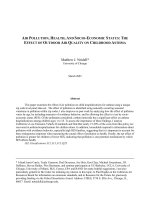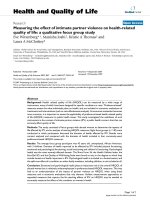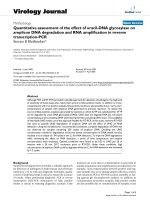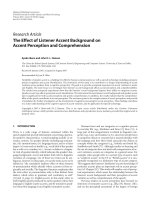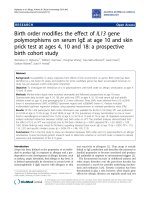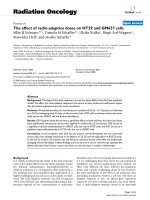Health insurance and health the effect of medicaid eligibility expansions on parent health outcomes
Bạn đang xem bản rút gọn của tài liệu. Xem và tải ngay bản đầy đủ của tài liệu tại đây (3.16 MB, 76 trang )
WILLIAMS COLLEGE LIBRARIES
Your unpublished thesis, submitted for a degree at Williams College and administered by the
Williams College Libraries, will be made available for research use. You may, through this form,
provide instructions regarding copyright, access, dissemination and reproduction of your thesis.
_ The faculty advisor to the student writing the thesis wishes to claim joint authorship
in this work.
In each section, please check the ONE statement that reflects your wishes.
I. PUBLICATION AND QUOTATION: LITERARY PROPERTY RIGHTS
A student author automatically owns the copyright to his/her work, whether or not a copyright symbol and
date are placed on the piece. The duration of U.S. copyright on a manuscript--and Williams theses are
considered manuscripts--is the life of the author plus 70 years.
_ I/we do not choose to retain literary property rights to the thesis, and I wish to assign
them immediately to Williams College.
Selecting this option will assign copyright to the College. This in no \vay precludes a student
author from later publishing his/her work; the student would, however, need to contact the
Archives for a permission form. The Archives would be free in this case to also grant perml',slcm
to another researcher to publish small sections from the thesis. Rarely would there be any reason
for the Archives to gram permission to another party to publish the thesis in its entirely; if such a
situation arose, the Archives would be in touch with the author to let them know that such a
request had been made.
_I/we wish to retain literary property rights to the thesis for a period of three years, at
which time the literary property rights shall be assigned to Williams College.
Selecting this option gi ves the author a few years to make exclusi ve use of the thesis in up-coming
projects: articles, later research, etc.
,..,/I/we wish to retain literary property rights to the thesis for a period of 1-7 years, or
until my death, whichever is the later, at which time the literary property rights shall be
assigned to Williams College.
Selecting this option allows the author great flexibility in extending or shortening the time of
his/her automatic copyright period. Some students are interested in using their thesis in graduate
school work. In this case. it would make sense for them to enter a number such as ' l O i n
the blank, and line out the words 'or until my death, whichever is the later,' In any event. it is
easier for the Archives to administer copyright on a manuscript if the period ends with the
individual's death--our staff won't have to search for estate executors in this case--but this is
entirely up to each student.
II. ACCESS
The Williams College Libraries are investigating the posting of theses online, as well as their retention in
hardcopy.
~illiams College is granted permi~sion to maintain and provide access to my thesis
in hardcopy and via the Web both on and off campus.
Selecting this option allows researchers around the world to access the digital version of your
work.
__ Williams College is granted permission to maintain and provide access to my thesis
in hardcopy and via the Web for on-campus use only.
Selecting this
network only.
_
a]]ows access to the
version of your work from the on-campus
The thesis is to be maintained and made available in hardcopy form only.
Selecting this option allows access to your work only from the hardcopy you submit. Such access
pertains to the
of your work. including any media that it comprises or includes.
III. COPYING AND DISSEMINATION
Because theses are listed on FRA.~CIS, the Libraries receive numerous requests every year for copies of
works. If/when a hardcopy thesis is duplicated for a researcher, a copy of the release form always
accompanies the copy. Any digital version of your thesis will include the release form.
~Pies of the thesis may be provided to any researcher.
Selecting this
allows any researcher to request a copy from the Williams College Libraries.
or to make one from an electronic version.
_ Copying of the thesis is restricted for _
any researcher.
years, at which time copies may be provided to
This option allows the author to set a time limit on
restrictions. During this period. an
electronic version of
thesis vvili be protected against duplication.
__ Copying of the thesis or portions thereof, except as needed to maintain an adequate
number of research copies available in the Williams College Libraries, is expressly
prohibited. The electronic version of the thesis will be protected against duplication.
Selecting this option allows no reproductions to be made for researchers. The electronic version
of the thesis will be protected against duplication. This
does not dis-allow researchers from
reading/viewing the work in either hardcopy or digital form.
Signed (student author) _
Signatures Removed
Signed (faculty advisor)_
Thesis title
+-\ E ';Ll\-\ I j\, S~ Li~ t--j (J;' N-J D \-\5:: J.\lru:
T~t;:" E F~ T () i=
Wt~DI(A( () ELl C-riJ)) Ll1'1 EX?A-i0 S\ ()~~ uN
Date
S! F? I loti
(
Accepted for the Libraries.
Signature Removed
/....::.t.;---,Gb'\,.l--'-(ci--_I
Date accepted _ _---'S.."..r'-_·.......
_
7-1\'02\'-1\ \-tGi\L\'t-\ 0\JlCC\1\L7
HEALTH INSURANCE AND HEALTH: THE EFFECT OF MEDICAID
ELIGIBILITY EXPANSIONS ON PARENT HEALTH OUTCOMES
by
Jessica Beck
Sara LaLumia, Advisor
A thesis submitted in partial fulfillment
of the requirements for the
Degree of Bachelor of Arts with Honors
in Economics
WILLIAMS COLLEGE
Williamstown, MA
May 19,2008
1
Abstract
This paper uses exogenous variation in Medicaid eligibility laws to evaluate
the effect of Medicaid eligibility expansions on the self-reported health of lowincome parents in expansion states between 1994 and 2006. I find that Medicaid
eligibility expansions are positively correlated with parental take-up rates although
they have no effect on parental health outcomes. I measure this relationship for four
different parent samples; mothers, parents, poor health parents, and parents with
income below 130% of the federal poverty line. The insignificant relationship
between eligibility expansions and health holds across all specifications except for
the sickest parents. For this population I find that the eligibility expansions reduce
the probability of being in poor health by 0.7 to 0.9 percentage points, or by 35-45%.
2
TABLE OF CONTENTS
Acknowledgements
4
Introduction
5
Background and Literature Review
9
A. Medicaid and Medicaid Eligibility Expansions
9
B. Literature Review
11
B.l Eligibility and Insurance Coverage
11
B.2 Eligibility and Health
12
B.3 Measures of Health: Self-Reported Health Status
13
Methodology and Data
15
A. Methodology
15
B. Data
21
C. Sample
25
Results and Discussion
29
A. Medicaid Coverage
29
B. Health Status
35
C. Possible Explanations
39
Conclusions
48
Tables
52
References
64
Appendix 1
67
Appendix 2
68
Appendix 3
71
3
Acknowledgements
This project owes a great deal of debt to the patience and guidance of my friends,
family, and professors. I would particularly like to thank Professor LaLumia for her
excitement, support, and willingness to explore this topic with me.
4
INTRODUCTION
Despite improvements in public health insurance coverage, in 2006 47
million people below age 65, or about 15.8% of the non-elderly population, were
uninsured. The majority of this population (79%) is adults below 300% of the federal
poverty line (Holahan 2007). Public policy and health care reform activists have
long been concerned with improving health insurance coverage. At the foundation of
these issues is the assumption that offering coverage to the uninsured will improve
their health by increasing access to quality medical care. Health insurance eligibility
expansions, the policy mechanism for improving coverage, are often motivated by
the desire to increase medical care utilization and health among the poor. However,
economists have not conclusively determined if there is a relationship between
insurance coverage and health. Eligibility expansions can lead to improvements in
coverage, but this does not necessarily increase utilization. In addition, even if
eligibility expands, this does not ensure that the uninsured actually take up insurance
coverage.
There is some reason to believe that extending insurance to the uninsured can
improve health. Relative to individuals with private insurance or Medicaid, the
uninsured population reports less access to primary care and preventive services.
According to a survey by the Kaiser Association, in 2004 44% of the uninsured did
not have a usual source of care. In contrast, only 18% of individuals with insurance
report lacking a routine care site. Additionally, the uninsured are also more likely to
delay or forgo care, allowing conditions to get worse; 51 % report not having seen a
doctor in the past year. Individuals with insurance coverage, through Medicaid or
5
private providers, report higher levels of access and use regardless of provider. In
contrast to the uninsured, 18% of those with Medicaid and 17% of individuals with
private insurance report not having a routine care source and 27% of individuals in
both plans report not having seen a doctor in the past year (Holohan 2007). The
similarity in these numbers and the sharp contrast between the behaviors of the
insured and uninsured suggest that expanding coverage is a viable way to improve
access to care, and subsequently, health. I test the hypothesis that Medicaid eligibility
expansions will improve the health of the newly eligible.
Economists have previously studied the effect of Medicaid insurance
expansion on insurance take-up and coverage. The majority of the work in this field
is concerned with the effect of expansions on children's health insurance coverage
and only a small number of papers focus on the coverage of non-elderly poor adults.
In studies that do focus on adult take-up, Medicaid expansions are believed to have
increased coverage among the previously ineligible (Grogger and Aizer (2003)).
Additional work that has analyzed the relationship between coverage, access to care,
and utilization of care suggest that insurance coverage is positively correlated with
each.
Few studies, however, have actually assessed the relationship between
insurance expansion and health and those that do use very small and specific
samples. Despite some conflicting results, most of these studies find small significant
effects of insurance on health. Using changes in California's Medicaid (Medi-Cal)
law, Lurie (1986) finds a small improvement in health for patients at LA clinics.
More notably, Currie and Gruber ((1996a) (l996b) (1997)) also find small positive
6
effects when measuring the effect of Medicaid expansions on the health of pregnant
women, children, and infants. Despite these positive findings, it is hard to generalize
this research because infants, pregnant women, and patients at LA clinics are
arguably quite different from the general population. As Levy and Meltzer (2001)
suggest, insurance expansions affect "vulnerable populations" who have the most to
gain from increased resources. The effect of insurance on the health of the general
population is less clear.
In this paper, I add to the small amount of literature that assesses the effect of
insurance coverage on health. I address the limitations of previous works by using a
general sample and a very general measure of health. To do this, I utilize changes in
state Medicaid eligibility requirements that occurred as a result of federal law
changes in 1996. During this time, the Personal Responsibility and Work
Opportunity Reconciliation Act (PRWORA) separated Medicaid eligibility
requirements from welfare eligibility rules. Between 1996 and 2001 many states
raised their income eligibility cutoffs and expanded coverage to parents of previously
eligible children. These changes varied in scale and occurred at different times in
different states, creating variation in eligibility laws both across and within states.
I use data from the CPS March Supplement to assess the effect of the 1996
Medicaid eligibility expansions on health status. I first measure the effect of the
eligibility expansions on insurance coverage and then, unlike previous work, on
health. My model is consistent with that used by Grogger and Aizer (2003) although
I expand it to measure the health of additional samples. The March Supplement is an
ideal data source because it over samples low-income individuals (those that qualify
7
for Medicaid) and provides in depth information on income, health insurance, and
state of residence. It also includes some information on health conditions. Unlike
other authors, I supplement my CPS health data with information from the Integrated
Health Interview Series (IHIS) in order to establish that my measure of health is
valid and provide additional insight on the health behaviors and conditions of those
that use Medicaid. This allows me to comprehensively assess the effect of insurance
expansions on the health status of the sample population.
8
BACKGROUND AND LITERATURE REVIEW
A. Medicaid and Medicaid Eligibility Expansions
Founded in 1965, Medicaid is a federal and state funded program that provides
health insurance to low income non-elderly adults and children. Medicaid eligibility
was historically linked to welfare participation and individuals or families who
qualified for AFDC aid were automatically enrolled in Medicaid. This population
mostly included unemployed and very low-income single mothers. Other lowincome working parents and families were above Medicaid income eligibility cutoffs
and did not qualify for the program. Over time, Medicaid became more inclusive and
the scope and scale of coverage greatly increased.
In the mid 1980s and 1990s, Medicaid coverage expanded to cover children and
pregnant women in both welfare and non-welfare families during "poverty related
expansions." By 1990, all states were required to cover pregnant women and children
up to eighteen years of age with income equal to or below 133% of the federal
poverty line. Vv'hile these expansions expanded coverage, they still targeted the same
historic population: low income pregnant women and their children.
In 1996, the passage of the Personal Responsibility and Work Opportunity
Reconciliation Act (PRWORA) fundamentally changed the eligibility requirements
for Medicaid. Better known for replacing AFDC with TAI\'F, the act also separated
Medicaid eligibility requirements from the requirements of other welfare programs.
In order to ensure that individuals with Medicaid did not lose coverage, states were
required, at a minimum, to use the initial AFDC income-eligibility requirements for
Medicaid after the passage of PRWORA. In addition, states were allowed to set their
9
own income cutoffs and redefine their income eligibility cutoffs as long as they were
above AFDC requirements. Funding for expansions came from a combination of
state and federal sources. Thus, as a result of PRWORA, states were able to offer
health insurance coverage to previously ineligible low income working adults.
This paper focuses on the 24 states that expanded eligibility between 1996 and
2004. Eligibility expansions occurred through three mechanisms: a redefinition of
income-eligibility requirements, a redefinition of earnings disregards, and an
application for research and demonstration waivers from the federal government. 1
Information on the timing of state expansions and changes in income-eligibility is
taken from Grogger and Aizer (2003). \Vhile it is hard to determine what exactly led
certain states to expand coverage, it is likely that they were responding to national
concerns regarding the number of uninsured adults and the rising cost of health care.
For the purposes of this study, I have not found any evidence that state expansions
were motivated by fears that the population in the expansion states were
experiencing declining health relative to non-expansion states.
Finally, it is also important to note that some members of the previously incomeineligible population could qualify for Medicaid under the "medically needy"
program prior to 1996. The medically needy program covers certain elderly, children
and very sick low-income adults that are otherwise not covered by Medicaid. Before
the passage ofPRWORA, the program was also used by states to expand coverage to
1 Income-eligibility is defined as a percent of annual family income relative to the
federal poverty line. Earnings disregards refer to certain amounts of money that a
family is allowed to deduct from their annual income prior to computing incomeeligibility. Research and demonstration waivers allow states to disregard certain
previously established limitations on care.
10
individuals and families above the AFDC income cutoffs (Holohan 2007). As a
result, it is possible that low-income adults in certain states actually had Medicaid
coverage despite otherwise appearing income ineligible.
B. Background Literature
B.l Eligibility and Insurance Coverage
Economists frequently use Medicaid expansions to assess the relationship
between insurance eligibility and insurance coverage. The majority of this work is
concerned with the effect of the expansions on insurance coverage and take-up of
low-income children. Cutler and Gruber (1996) find a 24% take-up rate among
newly eligible children between 1987 and 1992 but attribute 30-40% of the increased
enrollment to the crowding out of private insurance. After Medicaid expansions in
the 1980s and 90s, Dubay and Kenney (1996) find a 51 % take-up rate among newly
eligible children. They also find that 15-22% of this increase is attributable to
crowding out of private insurance. In contrast, later researchers including Dubay
and Kenney (1996), Yaziei and Kaestner (2000), and Shore-Sheppard and Card
(2004) find lower rates of child take-up and crowd out.
A smaller number of works assess the relationship between eligibility expansions
and adult insurance coverage. Cutler and Gruber (1996) find no statistically
significant increase in coverage among newly eligible women age 15-44 between
1987-1992. Grogger and Aizer (2003) analyze the same relationship after the 1996
expansions and find a statistically significant 2.7 percentage point increase in
coverage among newly eligible mothers and a small crowd out effect.
11
Unlike the majority of the works in this field, I do not look at the effect of
eligibility expansions on child coverage or health. Instead, I use Grogger and Aizer's
difference-in-difference model to assess the relationship between eligibility
expansions and insurance coverage for parents prior to analyzing changes in health.
In addition to replicating Grogger and Aizer's experiment, I also expand my sample
to include fathers.
B.2 Eligibility and Health
A small number of studies analyze the relationship between insurance coverage
and health using Medicaid expansions. These typically assess changes within one
state or focus on very specific segments of the population. Lurie (1986) uses
variation in California's 1982 Medicaid laws to assess the relationship between
insurance loss and health for the medically needy by measuring diastolic blood
pressure and self-reported health status. She finds that individuals who lost insurance
coverage experienced a statistically significant increase in blood pressure after 6
months and reported lower health status. Currie and Gruber (l996a) analyzes the
effect of the 1987-1992 Medicaid expansions on infant mortality rates, and pre-natal
practices of pregnant women. Using aggregate data from Vital Statistics and a
simulated eligibility variable from the CPS, they find that eligibility expansions
targeting pregnant women slightly reduced the incidence of low birth weight and
decreased infant mortality by 8.5% for every 30-percentage point increase in
eligibility. Similarly, Currie and Gruber (1997) demonstrate that increasing eligibility
for teen mothers and high school dropouts increased the use of obstetric procedures
12
and decreased neonatal mortality. Eligibility expansions are strongly correlated with
pre-birth treatments and for a 10 percentage point increase in eligibility neonatal
mortality falls by 2.3 percentage points. In a final study using the late 1980s
Medicaid expansions, Currie and Gruber (1996b) also find that increasing child (1-15
years) eligibility decreases child mortality. They estimate that a 15.1 percentage
point increase in child eligibility reduces child death resulting from disease by 8%.
\\11ile these works provide a wealth of information on the relationship between
eligibility expansions and health, they are limited in two key ways. First, each work
focuses on very specific populations: pregnant women, high school drop-outs, infants
and children. While these are important target groups for health care policy, they no
longer represent the majority of the uninsured population. Second, each study uses
specific measures of health: mortality, birth weight, and diastolic blood pressure.
These are strong indicators of health, but they do not take into account the variety of
other factors that are part of health such as chronic diseases, disabilities, or
psychological well-being. This paper addresses these limitations by focusing on a
segment of the population that still reports high levels of uninsurance, parents below
150% of the poverty line, and using a general measure of overall health, self-reported
health status.
B.3 Measures of Health: Self-Reported Health Status
A few papers also assess the relationship between self-reported health and
other health variables. These papers frequently analyze the relationship between selfreported health status, work disability variables, and labor force participation. Dwyer
13
and Mitchell (1999) find that self-reported health is strongly correlated with existing
health conditions while disability variables are more closely linked to variables that
measure the physical ability to perform work. 2 They ultimately report that general
self-reported health measures are slightly more variable than objective health
measures but both are viable and adequate proxies for health. Disability variables are
also adequate indicators of health, although they measure more physical components
of health. Baker, Stabile and Deri (2004) assess the relationship between general
self-reported health variables, objective health self-reports and actual health
conditions. They conclude that self-reported objective health variables are subject to
measurement error in similar ways as disability variables and general health
measures. 3
I use a self-reported health indicator as the key dependent variable in my
study and perform similar tests to ensure that it is a valid measure of health. Given
the relative accuracy of both objective self-report variables and disability variables I
regress these indicators on the self-reported health variable in the CPS. I use
additional data from the National Health Interview Survey (NHIS) to supplement the
CPS data. This dataset is well suited to analyzing the health of working age parents.
Case, Lubotsky and Paxson (2002) use a combination of objective self-reported
health indicators and a general self-reported health variable from the NHIS as
Generally, disability variables report the answer to "have you missed work in the
past year due to a disability or sickness?" Self-reported health status variables ask an
individual to rank his health on a 1 to 5 scale where 1 is typically excellent and 5 is
2
fOor.
Self-reported objective health variables report answers to "have you had X disease
in the past year." It is also possible that questions may extend the time horizon
beyond a year and ask if an individual has ever missed work or ever had a disease in
his entire lifetime.
14
proxies for child and parent health. I use the same variables when I regress selfreported objective health indicators on general health status.
15
METHODOLOGY AND DATA
A. Methodology
Health insurance lowers the price of health care for the individual and/or
family when consumption of medical care is necessary (Weissman and Epstien
1994). Conceptually, health insurance coverage allows an individual to access and
utilize care, which in tum is believed to improve health (Levy and Meltzer 2001). I
empirically assess the relationship between health insurance and health status by
testing the hypothesis that expanding eligibility for Medicaid leads to health
improvements for low-income parents. It is important to note that this paper only
briefly addresses the relationship between health insurance and medical care
utilization because data on utilization is not included in the CPS. Thus, while it is
possible that health insurance affects health status, it is not possible to specifically
identify how it does so in this experiment.
A major problem that occurs when assessing the relationship between
insurance and health is that health insurance may be endogenous to health status. It is
possible that poor health status motivates an individual to purchase health insurance,
or, equally likely, it is possible that people with health insurance are healthier
because they have insurance. In order to establish a causal relationship, I identify a
natural experiment that provides variation in insurance which is exogenous to health
status. I use changes in Medicaid eligibility laws as a source of variation because law
changes should be unconelated with health status. 4
It is possible that certain states chose to expand eligibility as a result of failing
health among their populations, however I do not find evidence of this phenomenon.
Instead, it seems likely that eligibility expansions were motivated by concerns about
4
16
Endogeneity is partially driven by adverse selection. For unobservable
reasons, some individuals may choose to purchase insurance while others may not. In
the typical example, the consumer of health care has more information about his
health status than the insurance provider. Individuals with poorer health may
purchase insurance while individuals with better health may not and the insurance
supplier cannot identify one from the other. In other words, there is the potential that
unobservable and unquantifiable characteristics motivate some people to buy
insurance and some people to remain uninsured. Conceptually, it is possible that the
traits which drive adverse selection also impact health. If these traits are
indistinguishable from insurance coverage it will be impossible to determine the
effect insurance coverage has on health. Thus, in order to establish a causal
relationship between health insurance and health status it is necessary to control for
the possibility of adverse selection. To address this issue, I use eligibility laws as a
source of variation instead of actual insurance coverage status. I compare individuals
who were always income-eligible for Medicaid to those that become income-eligible
after the 1996 expansions. A major limitation of this method, however, is that I am
not measuring the effect of actual coverage on health.
The 1996 Medicaid eligibility expansions occurred at different times in
different states. Additionally, the scope of the expansions varied greatly by state.
health insurance inequity and the high rate of uninsurance in the United States. Prior
to expansion, the mean health in expansion and non-expansion states is very similar;
in 1995-1996 the mean health was equal to 2.31 and 2.35, respectively. Additionally,
the correlation between health and expansion is only -.01. This suggests that while
expansion and non-expansion states may differ in key ways, these differences are not
correlated with the dependent variable I wish to study.
17
Consistent with Grogger and Aizer (2003), my sample only includes states that
expanded eligibility between 1996 and 2004. Table 1 lists the expansion states along
with the expansion years and eligibility requirements. In addition to the Medicaid
expansions, welfare reform, and an economic boom also occurred during the 1990s.
In order to control for different attitudes towards welfare, different economic
environments in each state, and other potential policy endogeneity issues I use
Grogger and Aizer' s method of comparing populations within expansion states
instead of across all states.
5
States determine Medicaid eligibility on a monthly basis but normally
calculate eligibility income as a percentage of annual family income relative to the
federal poverty line. To separate the always eligible from the newly eligible I create
two mutually exclusive groups within each state, control and treatment. Members of
the control group are always eligible for Medicaid and have income below the preexpansion income cutoff. With a few exceptions, members of the treatment group are
only eligible for Medicaid after the expansions have occurred. I also define a second
control group, control 2, which includes individuals that are always income ineligible
for Medicaid. These individuals are above both the original income-eligibility cutoff
and the expanded income-eligibility cutoff. Medicaid eligibility expansions primarily
targeted parents although a minority of states later changed income-eligibility rules
Medicaid eligibility rules in non-expansion states are based on and extremely
similar to the AFDC income-eligibility requirements prior to 1996. These may be
different in expansion and non-expansion states. Prior to the passage of PR\VORA
expansion states provided higher mean AFDC benefits than non-expansion states. In
1994, the mean AFDC benefit for a family of three was $444.67 in expansion states
and $353.85 in non-expansion states.
5
18
for childless adults. I use the more generous of these two eligibility expansions and
restrict my sample to only low-income parents. 6
Prior to measuring the relationship between eligibility and health, it is
important to assess what affect the expansions had on coverage rates. I replicate part
of Grogger and Aizer (2003) to test the relationship between eligibility expansions
and Medicaid coverage. 7 Based on Grogger and Aizer's model, I estimate the
following regression:
Medicaid Coverage = ~l + ~2 Treatment + ~3 Interact + ~3 Years + ~4Age + ~sRace +
~6# Child
+ ~7Education + ~8 Married + ~9 Sex + ~9 Unemp + f.l
(1)
where MEDICAID COVERAGE is a dummy variable equal to one if the individual
has coverage and TREATMENT is a dummy variable equal to one if income is
between the pre expansion and post-expansion cutoffs. INTERACT is a variable that
captures the effect of being in the treatment group after eligibility expansion. The
coefficient on this variable represents a difference-in-difference estimate that
compares the change in coverage between the control and treatment groups.
MARRIED is a dummy variable equal to one if an individual is married, AGE is
In 2004, there were 11.1 million uninsured parents and 25.5 uninsured childless
adults in the United States with income below 300% of the FPL (Holahan et al
2007). Despite representing a larger uninsured population, eligibility expansions did
not target childless adults and I remove them from the sample.
7 Grogger and Aizer (2003) restrict their sample to low-income mothers. In order to
compare my results to their findings I initially restrict my sample to low-income
mothers. I then run a separate regression for both mothers and fathers.
6
19
measured by year, and SEX is equal to one if the individual is male. RACE is
composed of WHITE and BLACK dummy variables equal to one if the individual
falls into either category and OTHER is the omitted race category.8 EDUCATION is
equal to years of education and the YEAR variable is a vector of individual year
dummy variables equal to one for each year 1995-2006 (1994 is the omitted year).9
To account for the effect of business cycles and economic conditions on Medicaid
coverage I also include the annual unemployment rate in each state, signified by the
variable UN'EMP.
I am also interested in the effect of eligibility expansion on private insurance
coverage and I estimate equation (1) with private insurance as the dependent
variable.
After assessing the relationship between eligibility and insurance coverage I
estimate the relationship between eligibility and health status given the following
equation:
Health
= ~l
+ ~2Treatment + ~3 Interact + ~3 Married + ~4Age + ~5Race +
~6# Child + ~7Education + ~8 Years + ~9 Sex + ~9 Unemp + fl
(2)
where HEALTH is a dummy variable equal to 1 if parents self-report a health of 1 or
2. It is based on a categorical variable HEALTH STATUS, which has a value of 1-5
where 1 corresponds to excellent health and 5 corresponds to poor health. The other
8This group includes Hispanics, Asians, Native Americans, Pacific Islanders and any
individual who responded to the CPS survey question in race by marking "other."
9 I also use a specification by age group: 19-29,30-40, and 41-50 and include an agesquared term.
20
variables are defined in the same way as those in equation (1). Given the hypothesis
that becoming insured will improve health, one would expect the health of the
treatment group to improve after expansion relative to the health of the control
group. Because HEALTH is a dummy variable equal to 1 for good health, I predict
that the coefficient on INTERACT will be positive if the health of the treatment
group improved after the expansions.
I also include other variables that may affect health. I control for
demographic characteristics such as race, sex, marital status, number of children, and
education. Because Medicaid has different eligibility requirements for mothers,
fathers, and childless adults, I restrict the sample to only include mothers and fathers
aged 19-50. To control for year effects and the business cycle, I also include a full set
of year dummies and the annual unemployment rate in each state for 1994-2006.
In addition to estimating equations (1) and (2) I am also interested in the role
of time on coverage and health status. I hypothesize that it may take more than one
year for eligibility expansions to affect coverage and health. To investigate this
possibility, I replace the year dummies with three dummies equal to 1 for
observations 1,2, and 3 or more years after the eligibility expansions. I replace my
previous interaction term with the interaction of the treatment variable and the new
dummies.
To explore the hypothesis put forth by other authors that changes in insurance
status will have the greatest impact on medically vulnerable populations, I also
estimate this equation using the dependent variable SICK which is a dummy variable
21
equal to 1 for parents that report a health status of 5. 10 In this specification, I would
expect the coefficient on INTERACT to be negative after expansion.
I first use OLS to estimate how eligibility expansions affect coverage and
health. Then, because both MEDICAID COVERAGE and HEALTH are limited
dependent variables I run probit regressions in order to address the possibility that
my OLS coefficients are biased. I also include weights in each regression to ensure
that my sample is representative of the general population.
Finally, because my unit of observation is the individual but the variation in
treatment is at the state level, residuals may be correlated at the state level, biasing
my standard errors (Moulton 1990). To address this possibility I report clustered
standard errors.
B. Data
My primary dataset is the CPS March Supplement. The CPS March
Supplement is an annual survey that provides detailed information on income,
demographics, and health insurance status. It also contains individual, family, and
household data about health status and state of residence, making it a good data
source to study state-by-state Medicaid expansions. \Vhile I use data from 19952007, the CPS income and insurance statistics lag by one year so the sample years
are actually 1994-2006. This time period is ideal for two reasons. First, Medicaid
eligibility expansions began in the early 1990s but the early expansions suffered
Case, Lubostky and Paxson (2002) use self-reported health status to target lower
health populations.
10
from under-funding and flawed implementation (Grogger and Aizer 2003).11 In
contrast, the 1996-2001 period is characterized by a large number of substantial and
fully funded expansions made possible by the passage of PRWORA. Additionally,
the CPS March Supplement was redesigned in 1994. To avoid discrepancies in
question interpretation and to ensure variable comparability across all years in my
sample I only use data from the redesigned survey.
The CPS collects information on a variety of individual and family income
types throughout the year. Specifically, information is provided on weekly wages,
annual earnings, and additional non-wage income. The CPS also contains a
constructed variable that describes annual family earnings as a percentage of the
federal poverty line. This is helpful because Medicaid eligibility is based on family
monthly earnings but is frequently expressed in annual terms relative to the federal
poverty line. I utilize the CPS variables for annual family earnings relative to the
poverty line to generate income measures by family and use them to assign parents to
either the treatment or control group. All income-eligibility measures in this study
are expressed as percentages of the federal poverty line.
Despite the detailed income information in the CPS, using CPS data does
present some problems. J'v1edicaid enrollment and eligibility is based on monthly
family income while the income data available in the CPS is reported annually.
\\illile I use variables that relate annual family income to the federal poverty line,
Five states, Washington, Minnesota, Oregon, Tennessee, and Hawaii, chose to
expand Medicaid coverage to low income adults prior to 1996 (Grogger and Aizer
2003). These expansions, however, were severely under funded and resulted in
coverage cutbacks. It is hard to determine exactly who among the technically
income-eligible received care and coverage.
11
23
